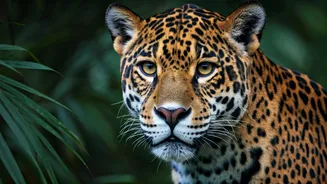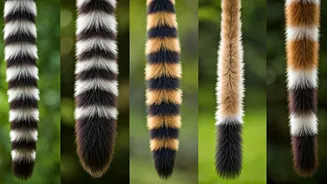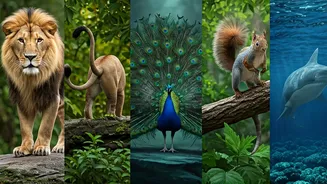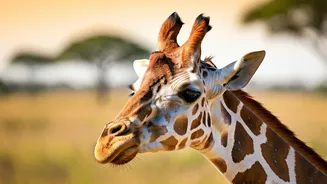Orcas: Ocean's Apex Predator
Orcas, also known as killer whales, are among the most fearsome predators in the ocean, and their societies are frequently led by females. These intelligent
marine mammals exhibit intricate social structures, passing down hunting techniques and crucial survival knowledge through generations, ensuring their legacy and the success of their pods. These apex predators, known for their size and power, work together in coordinated hunts, targeting seals, whales, and even sharks. Their strategic brilliance and cooperative hunting methods showcase a level of intelligence and adaptability that is essential for thriving in diverse marine environments. Orcas demonstrate a complex social life within their matriarchal pods, where knowledge and skills are passed down through generations. These skilled hunters have perfected techniques like beaching themselves to capture seals or creating waves to dislodge prey from ice floes, highlighting their intelligence and cooperative efforts.
Spotted Hyenas: Cooperative Hunters
Spotted hyenas are renowned for their strength and social complexity, with females leading the clans. Their cooperative hunting behaviors and ability to adapt to various food sources are quite impressive. They live in hierarchical clans where females usually dominate, a fact that influences everything from resource access to mate selection. These carnivores display complex social interactions within their clans, which facilitate sophisticated hunting strategies. They hunt collaboratively, ambushing prey, and are quite skilled scavengers. Hyenas’ unique vocalizations also help them communicate over long distances, assisting with coordinating group activities like hunting or defending territories. They play a vital role in their ecosystem, keeping the balance and health of the environment, and contributing to the stability of their habitats.
Black Widow Spiders: Deadly Venom
Black widow spiders are known for their potent neurotoxic venom, and their hunting skills are also worthy of respect. These spiders build intricate webs to trap insects and other small creatures. The females, particularly, are recognizable by their distinctive red hourglass marking on their abdomens and are considerably larger than the males. They are ambush predators that lie in wait for their prey to get caught in their webs. Once an insect is caught, the spider quickly injects its venom, which paralyzes the prey. This strategy allows the black widow to hunt efficiently and survive in diverse environments. Their adaptability and ability to produce venomous toxins make them fascinating and fearsome predators.
Tasmanian Devils: Scavenging Powerhouses
Tasmanian devils are the world's largest carnivorous marsupials, and the females are fierce scavengers. They are known for their ferocious nature, particularly when feeding. They possess incredibly powerful jaws and teeth that allow them to consume entire carcasses, including bones. Tasmanian devils also play a critical role in their ecosystems, helping to clean up decaying matter and maintain the balance of the ecosystem. The males and females typically display unique territorial behaviors, contributing to the species' survival. The females are typically responsible for rearing their young in a pouch, ensuring the survival of their offspring and the perpetuation of the species. The resilience of these animals in the face of environmental challenges highlights their toughness.
Sloth Bears: Foraging Specialists
Sloth bears, found in South Asia, are unique among bear species, with females exhibiting incredible foraging skills. These creatures have long claws and strong noses, which help them to dig up insects like termites and ants. The bears' specialized mouths and tongues are used to suck up the insects with a loud slurping sound. Females are very protective of their cubs, and they carry them on their backs during foraging expeditions, teaching them about the environment and the best foraging sites. Their critical role in the ecosystem is undeniable; they influence the habitats they inhabit through their foraging behaviors and help to control insect populations.
Praying Mantises: Stealthy Hunters
Praying mantises, with their exceptional camouflage skills, are masters of stealth. The female mantises are well-known predators, with their large eyes and flexible necks. They are capable of rotating their heads nearly 180 degrees to easily spot potential prey. These insects lie in wait, patiently camouflaged, until an insect ventures too close, where they swiftly capture their target using their spiny front legs. Their ability to remain still and blend into their surroundings makes them exceptionally successful hunters. The praying mantis life cycle includes the female’s laying of eggs in an ootheca, which protects the developing nymphs, ensuring the species' survival in various environments.
Meerkats: Vigilant Guardians
Meerkats are highly social creatures, and their female members are crucial in the defense of their territories. They live in complex social groups where different family members take on distinct roles, like the 'sentinel,' which stands guard and looks out for predators. The sentinels alert the group, which helps protect the colony from potential dangers. Female meerkats may have multiple litters throughout the year, and they often co-parent with other females in their group, showcasing incredible cooperation. They contribute significantly to their environment, their vigilance acting as a critical line of defense against predators, and their social structures provide a fascinating illustration of the importance of community.
Mosquitoes: Bloodthirsty Females
Mosquitoes, while small, are among the most globally significant predators, and the females are the ones that hunt. They require blood meals to produce eggs, which makes them carriers of diseases. Their hunting approach is to locate a host using various sensory cues, and they then pierce the skin using their proboscis to access blood. They often transmit diseases like malaria, dengue fever, and Zika virus. Their prevalence in various ecosystems and the diseases they carry have had a notable effect on public health and the global efforts to control these creatures.
Portia Spiders: Intelligent Hunters
Portia spiders are known for their intelligence and innovative hunting strategies. They are jumping spiders and can be found in various habitats. Their sophisticated approach to hunting includes mimicking other spiders to lure them. Their ability to solve complex problems and display cognitive skills beyond those of other spiders is really quite impressive. Their hunting abilities showcase a degree of problem-solving that reflects their evolution and the survival skills required in a complex environment. Their ability to hunt effectively, coupled with their intelligence, makes them standout predators.
Mantis Shrimp: Powerful Strikes
Mantis shrimp are known for their aggressive behavior and the incredible power of their strikes. Females display a range of colorful patterns and have remarkable eyes, capable of seeing a wider array of colors than humans can. They use their specialized appendages to deliver incredibly fast and powerful strikes, capable of breaking through the shells of their prey. Their hunting approach combines stealth and an exceptional physical capability. Mantis shrimp also demonstrate a complex social life. They are fascinating examples of natural adaptations for survival and highlight the wide range of strategies employed by predators.







